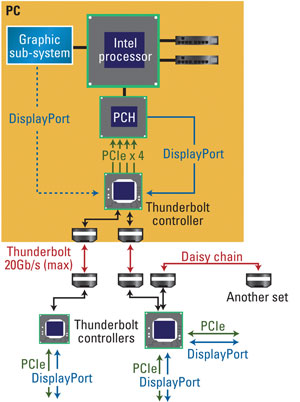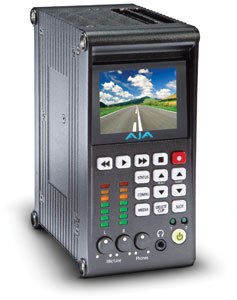AJA’s Io XT, Ki Pro Quad
Thunderbolt technology has been around for a year and a half now, and it is still difficult to overstate its importance for broadcast professionals. Since it came to market on Macs in February 2011, legions of video editors have relied on Thunderbolt to efficiently power greater speed and data transfer capabilities. With the recent announcement that Thunderbolt is now coming to Windows as well, its adoption is about to become even more widespread.
Tech specs
Initially developed by Intel with technical collaboration from Apple, Thunderbolt is a peripheral connection technology, combining PCI Express (PCIe) and DisplayPort into one serial data interface. This new technology combines data, video, audio and power in a single connection, and can transfer bi-directionally at 10Gb/s over a single cable. It also allows for high-speed connection of various peripherals including video capture solutions, hard drives, RAID arrays, network interfaces, and more — meaning that users can connect external devices to a Mac and get PCI Express performance. In addition, each port also provides up to 10W of power to peripherals, allowing users to tackle workstation-class projects. Users can also daisy-chain up to six peripherals. (See Figure 1.) Another key point for video editors is that the connection technology, via the power of PCIe, offers low latency with highly accurate time synchronization for audio and video applications.

Figure 1. This shows that Thunderbolt allows the PCIe bus to be extended beyond the host enclosure.
The effect on video editors
Traditionally, video editors have faced one major roadblock: They can only work as quickly as the throughput of their devices and connections will allow. This leads to speed/productivity, workflow and portability/mobility issues. Editors have been limited by sluggish connection speeds, chassis boundaries, and number of ports available, just to name a few. But, Thunderbolt is changing all of that.
The new technology’s proven speed is 20X faster than USB 2.0, 12X faster than FireWire 800 and twice as fast as USB 3.0. Plus, neither USB nor FireWire offers bi-directionality. And, unlike USB and FireWire, since Thunderbolt supports data, audio, video and power, only a single port and cable needed to connect many peripherals. Also, devices of varying performance levels can be connected without affecting the channel itself.
The professional video industry's #1 source for news, trends and product and tech information. Sign up below.
Furthermore, the speeds possible with Thunderbolt were previously only possible on large desktop workstations. The peripheral connection technology frees users from traditional chassis boundaries, allowing needed power to be accessed externally via Thunderbolt connectivity to the CPU. This is a welcome significant leap for editors, as they can now harness equivalent desktop power on portable, mobile applications. Thus, even laptops can now handle top-quality professional video at faster speeds. Editors can pair laptops with portable storage and I/O options and have the same-quality NLE system on the go.
Workflow solutions
AJA Video offers several different solutions for Thunderbolt-enabled workflows, from acquisition to editing and conversion.
Io XT is the company’s portable video capture and playback device for professional post-production and on-set workflows. It offers 3G/Dual Link/HD/SD-SDI I/O, component analog and HDMI connectivity, plus full uncompressed 2K YUV, HD and SD 4:2:2 and 4:4:4 capable video and audio connectivity. It also offers dual Thunderbolt ports for efficient daisy chaining, and an RS-422 connection to enable control of external decks and other recording devices directly within a software application of choice, without the need for a separate device control adapter.
It offers complete compatibility with the most popular NLE programs, the newest codecs, video formats and stereo 3-D workflows, and software from Apple, Avid, Adobe, Autodesk, and more. The capture and playback device also uses AJA’s up/down/crossconversion hardware. This allows for conversion upon capture or output without having to change the native editorial timeline, thus providing the freedom to work in a preferred format. Notably, the device can cross-convert 720p 23.98 to 1080PsF 23.98, a growing need in the post world. The combination of Io XT with a MacBook or Mac mini offers new possibilities for easily portable professional editing systems.
Televisa, the world’s largest Spanish language broadcaster, deployed a significant new build-out that linked sites across London and Mexico City to power its coverage of the London 2012 Olympics. In London, 24 Io XT Thunderbolt-enabled video I/O devices were used together with Sienna PictureReady systems to write media and proxies onto 460TB of active storage. This enabled real-time ingest of Olympics footage from London to Mexico, with edits from Mexico transferred back to London as finished sequences.

Figure 2. Thunderbolt allows rapid ingest of 4K ProRes files.
In Mexico, all of the sports broadcasting infrastructure that had been used for the Beijing Olympics was integrated and compatible with all of the new equipment. All of the ingest and playout tools in London took advantage of the throughput to enable high-speed, high-resolution file exchanges. Additional improvements facilitated by the Thunderbolt workflow included savings in space, energy and cooling — as well as the actual cost of the equipment by using a Mac Mini as a server device. Thunderbolt also allowed Televisa editors to use MacBook Pro and iMac computers to connect directly to the high-speed Active Storage shared storage.

AJA’s Ki Pro Quad can record 4K, 2K or HD files directly to removable SSD modules.
The forthcoming Ki Pro Quad unites various components of a 4K workflow in one compact and powerful Thunderbolt-enabled package. It can be used in multiple data workflows including RAW and ProRes, and lets users record 4K, 2K or HD files directly to removable SSD modules. (See Figure 2.) Once removed, the SSD can be inserted into AJA’s SSD Reader, which connects directly to a Mac device via Thunderbolt, allowing for rapid file transfers that are immediately ready to use in an NLE system. The use of SSD modules provides the bandwidth to move data quickly with no bottlenecks via the reader. Ki Pro Quad uses Thunderbolt to serve as a powerful addition to any post workflow.
The future
As more third-party vendors develop Thunderbolt-enabled peripherals for both Mac and Windows, the efficiency of Thunderbolt will spread to more parts of the workflow chain, and users will be increasingly able to manage larger and more complex file types on the go.
As it becomes more possible to have an affordable, completely portable, efficient and top-quality NLE system via the connection technology, the possibilities for production and post continue to grow, allowing Thunderbolt to be viewed as the future of editing.
—Bryce Button is product marketing manager, AJA.
